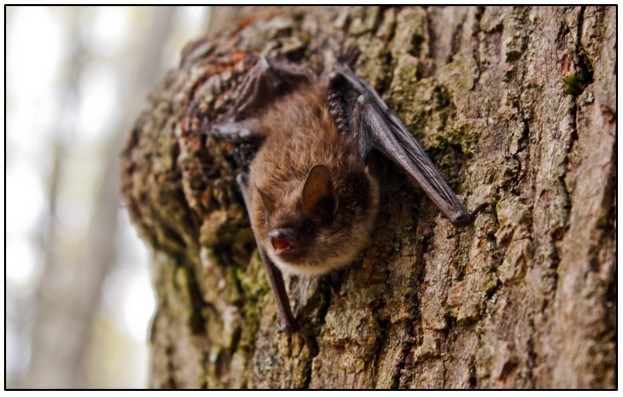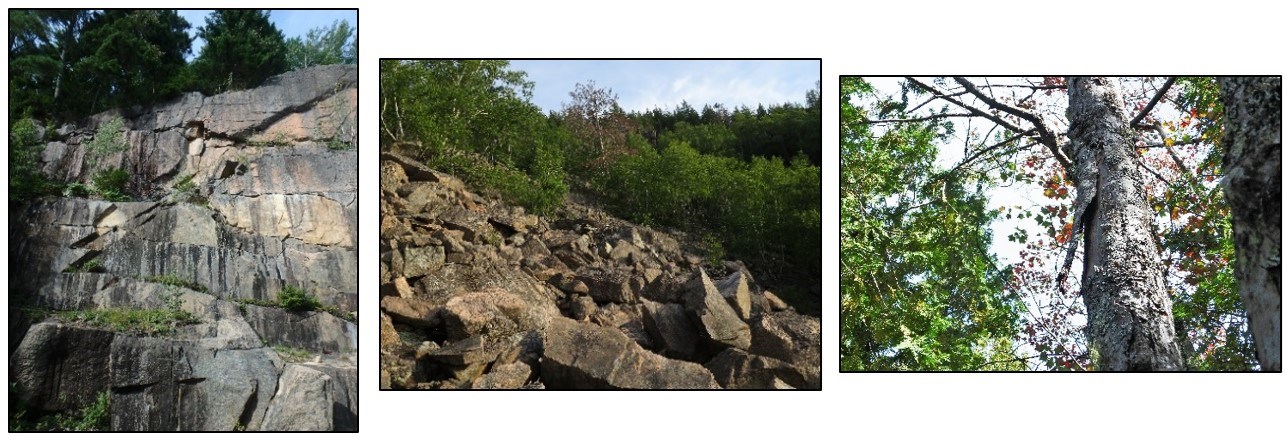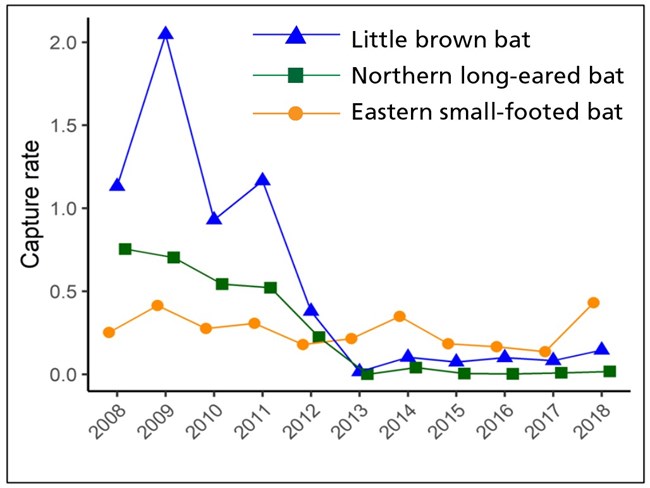Last updated: October 25, 2024
Article
Bats in Acadia: Facing Challenges but Hanging On

Photo credit © Erickson Smith.
Acadia National Park (NP), in coastal Maine, has a total of eight species of bats during at least part of the year. The park, almost 50,000 acres in size, is largely forested but also includes non-forested wetlands, freshwater lakes and ponds, and exposed rock features such as granite cliffs and outcroppings. What does Acadia not have that is often associated with bats? The answer is caves. So where do bats live in Acadia? How do park biologists keep track of their populations? And how are they doing since the arrival of WNS?
Acadia’s Bats and Where They’re Found
All bat species in Maine are also found in Acadia NP. Of these eight bat species, five can be found in the park all year (and hibernate here), and three are migratory (and not found in the park in the colder months). One of the year-round species, Northern long-eared bat (Myotis septentrionalis), is on the federal Endangered Species List. The other year-round species are little brown bat (Myotis lucifugus; state endangered), Eastern small-footed bat (Myotis leibii; state threatened), big brown bat (Eptesicus fuscus), and tri-colored bat (Perimyotis subflavus).
Bats in Maine use a variety of habitats, including forests, fields, wetlands, ponds, and mountain slopes. During their active period in May through mid-October (outside of winter hibernation), bats in Acadia use the following features for day roosts: rock crevices and outcrops, trees (small cavities or under loose bark), and, sometimes, buildings or other human structures. When hibernating in the park, bats primarily use rock crevices, including in talus slopes (see photo), and human structures.

NPS photos.
The Threat and Impact of White-nose Syndrome
Some bat species in North America, including in Acadia NP, have been affected by the disease white-nose syndrome (WNS). White-nose syndrome, which can give a fuzzy white appearance to a bat’s muzzle and wings, is caused by a fungus and has resulted in dramatic population declines. Bats declined significantly in the park after the appearance of WNS in 2011–2012, with the three Myotis species and tri-colored bats the most affected. This disease has been a significant cause for concern and potentially makes it more difficult to monitor bats given their lowered numbers. Bats, however, persist in Acadia NP.
How do we Monitor Bats?
The National Park Service (NPS) protects bats and their habitats. Managers at Acadia NP have been monitoring bats since the mid-1990s. This long-term monitoring program is vital, because we need to know where bats are and how they’re doing in order to better protect them.

Illustration by NPS/Jen Strona.
Biologists use mist nets to catch bats at specific locations in the park. By recording the number of bats caught each year, biologists can determine an index of abundance. This index can be compared over time to get an idea of how the population is doing. Mist netting involves catching bats in a fine, stationary net, collecting information on them (such as the type of bat and whether they show signs of WNS), and releasing them unharmed.
Another, more high-tech way of monitoring bats is based on their use of echolocation to navigate and catch insect prey. Since humans can’t hear bat calls, scientists developed acoustic call recorders to record the bats’ sounds. To analyze the recorded calls, special software is used that helps biologists identify the species that made the call, when the call was made, and whether the bat was feeding or navigating when it was recorded. This method of monitoring bats is efficient and less intrusive for the bats. Acadia NP biologists recently updated their acoustic monitoring program to best meet their monitoring goal of assessing long-term trends in the park’s bat community.
Want to hear an acoustic recording of a little brown bat?
In this recording, the little brown bat makes numerous, quick echolocation calls, or chirps, to navigate or search for prey. The lower-pitched sounds that start half-way through the recording are not from a bat. The audio has been modified so the human ear can hear it, and the accompanying spectrogram (the moving image) is a graphic representation of the sounds. The red line at the top of the spectrogram indicates how loud the sound is (the amplitude), with larger waves representing louder calls. The main (center) part of the spectrogram shows the frequencies of the calls (scale in kilohertz on the right vertical axis). The varying intensity of colors, ranging from dark blue (low intensity or quiet) to red (high intensity or loud), indicates the loudness (amplitude) of each call.
Transcript
- Duration:
- 9.328 seconds
Acoustic Recording/Spectrogram Credit: Dr. Erik J. Blomberg, University of Maine
What does Recent Research Tell Us?
Recently, biologists at the park and partners at the University of Maine have been studying bat use of different areas in the park, the impact of WNS on their numbers, and how to better monitor the bats as population levels decrease.
Updated bat monitoring protocol
Under the revised bat monitoring protocol, biologists are sampling more (now one-half) of the park and revisiting the same survey sites every 2 years. Acoustic recorders are set out at a given site for about two weeks at a time in locations likely to be used by bats as travel corridors or foraging habitat.
Long-term bat declines
Based on data from the park’s mist net surveys, it appears that relative abundance of Northern long-eared bats and little brown bats declined by 90% or more after the arrival of WNS (Figure 1).
In comparison, relative abundance of Eastern small-footed bats was fairly stable over the same period, and this species was the most frequently encountered over the second half of the study period. Note that while tricolored bats have also been affected by WNS it is rare to catch them with mist nets, so they don’t show up in this dataset. They do show up, however, in the park’s acoustic recordings. Also note that we captured particularly high numbers of little brown bats in 2009 because we surveyed near maternity colonies.
While the abundance of little brown bats and Northern long-eared bats declined significantly after the appearance of WNS, they stabilized at lower levels during 2015–2018 (based on both mist net data and acoustic data). These results provide some level of optimism for the persistence of bats in Acadia NP.
Bat presence in different areas of Acadia, 2019–2020
Based on acoustic monitoring in 2019–2020, little brown bats were the most common species in Acadia in those years, followed closely by Eastern small-footed bats. Each species was present in about one-half of the park sites surveyed. Northern long-eared bats were the least common species in 2019–2020, found in about one-fifth of the park sites. This information, and similar information on the other bat species recorded, will provide the baseline for bat monitoring in Acadia NP into the future.
Listening to bats: 2024 update
From now until the end of October, sound detecting units in the woods and meadows will record the calls of the eight species of bats in Acadia as they use echolocation to navigate their nocturnal world.
Acadia National Park wildlife biologists Bik Wheeler and Molly Donlan will process the recordings through computer software that converts them into spectrograms (a visual representation of the sound). Each bat species has a unique vocalization, and can be identified based on certain characteristics of the spectrogram. “Once the calls are classified to species, we can analyze the data to estimate how the population is changing over the years,” said Wheeler.
The current acoustic monitoring program began in 2020. Ten years of data are required to confirm any trends, although preliminary data suggest bats are staying stable at low numbers. This is good news considering Myotis and Perimyotis bat populations are still a fraction (14 %) of what they used to be before White Nose Syndrome, which has been affecting Acadia’s bats since 2011.
“Myotis and Perimyotis bats reproduce relatively slowly compared to other mammals of their size – they only have one pup a year! – so even if populations are stabilizing and growing, it will likely be years before we see a notable rebound,” said Wheeler.
The acoustic recordings complement bat sampling and tagging. With assistance from Biodiversity Research Institute (BRI), Acadia National Park conducts two seasons of mist-netting, in early and late summer. These fine, soft nets are stretched across known bat travel corridors and foraging and roosting areas at night. Immediately after capture, bats are banded, weighed, and tested for the fungus (Pseudogymnoascus destructans) that causes White Nose Syndrome before being released. This year the BRI teams captured four Northern long-eared bats, a federally endangered species.
“Two of them were caught in in the same net at the same time; one was a post lactating female and one was a juvenile male. It is likely this was a mother and pup, and implies that there are northern long eared bats reproducing in the park,” said Wheeler.
They also re-captured an Eastern small-footed bat last seen in 2019. Both times, this bat was pregnant. Capture provides an up-close look individual bats, helping park biologists gain a deeper understanding of a small portion of bats in the park. Just knowing that some bats are surviving and reproducing year after year, which is essential for a rebound in the population, is encouraging, and helps provide a more holistic insight into the acoustic monitoring data.
Information on bats in Acadia is shared NABat, a continent-wide bat monitoring project. Collaboration is essential to understanding changes in populations, especially for cryptic animals like bats that are not always easy to study and do not have an extensive history of research.
Information in this article is based primarily on: Blomberg, E. J., C. Heilakka, B. Wheeler, L. Katz, M. Ingalls, and M. Donlan. 2023. The past, present, and future of bat population monitoring in Acadia National Park: Focused condition assessment. Natural Resource Report NPS/ACAD/NRR—2023/XXXX. National Park Service, Fort Collins, Colorado. [Publication Pending]
